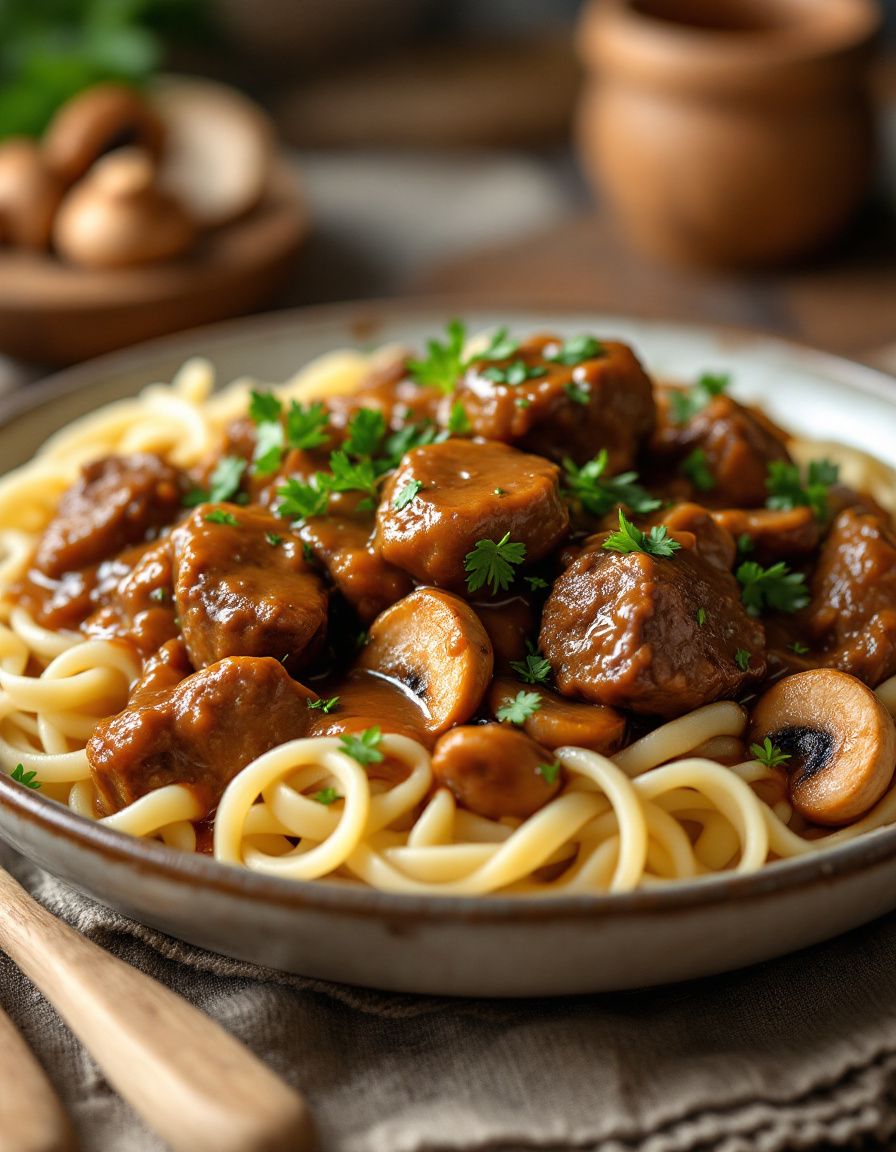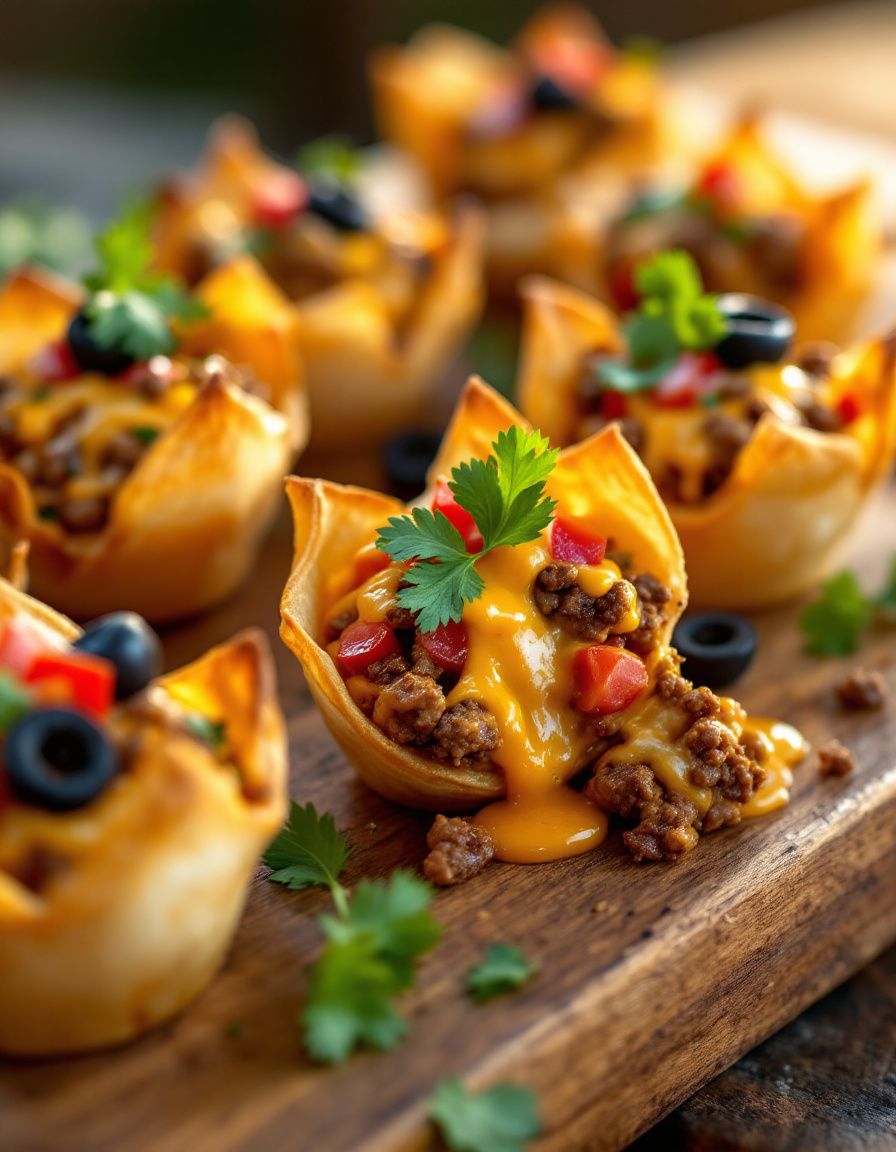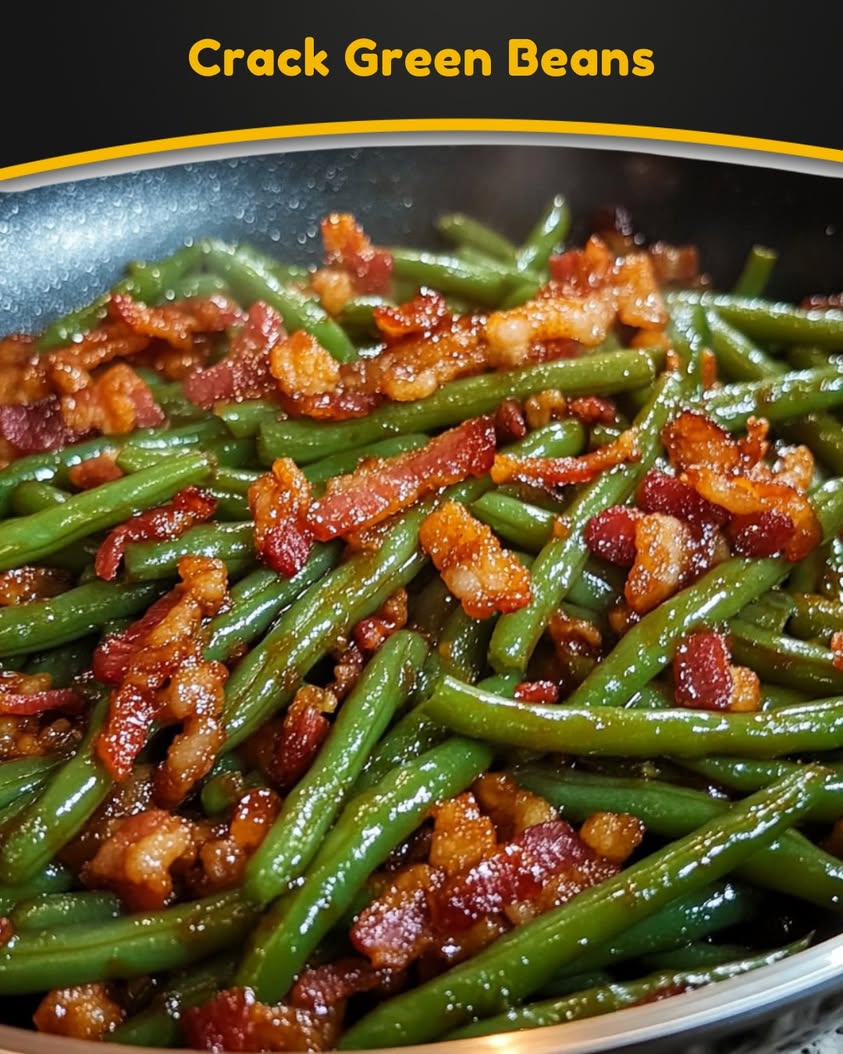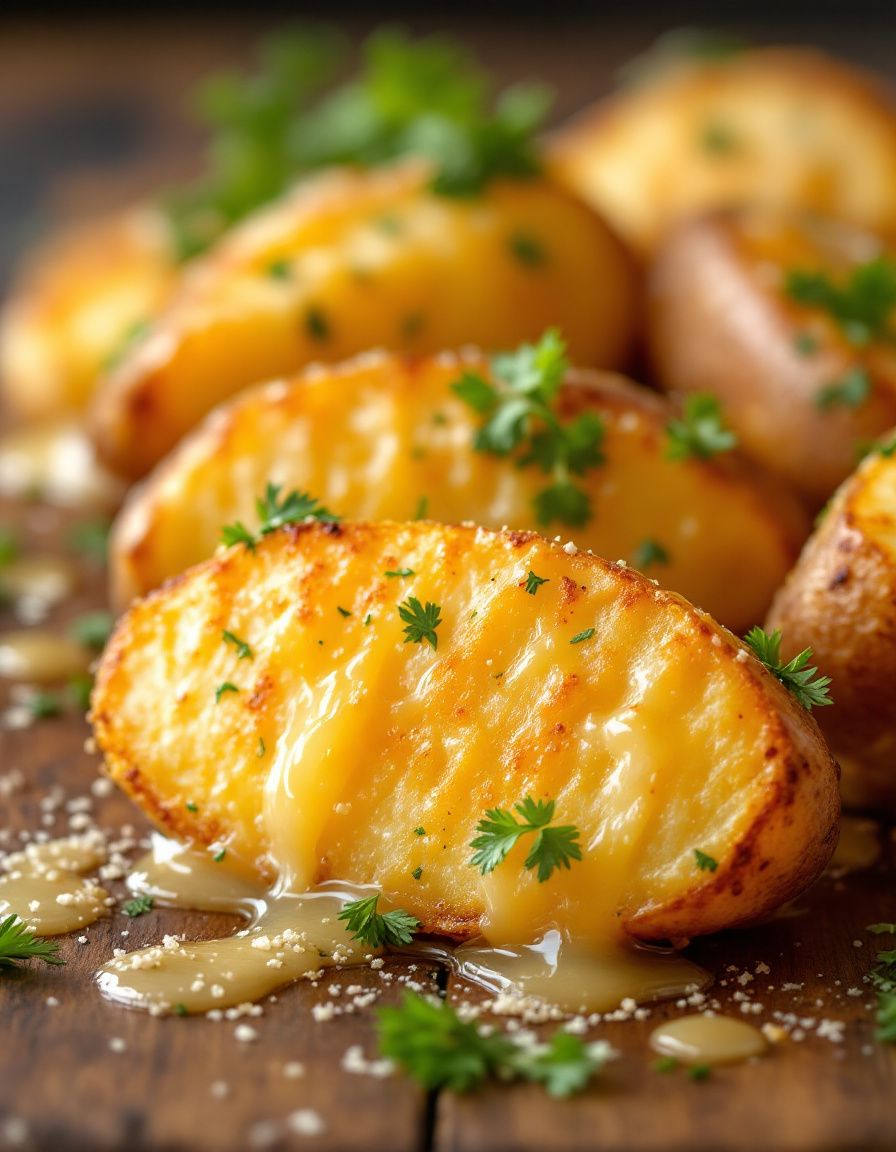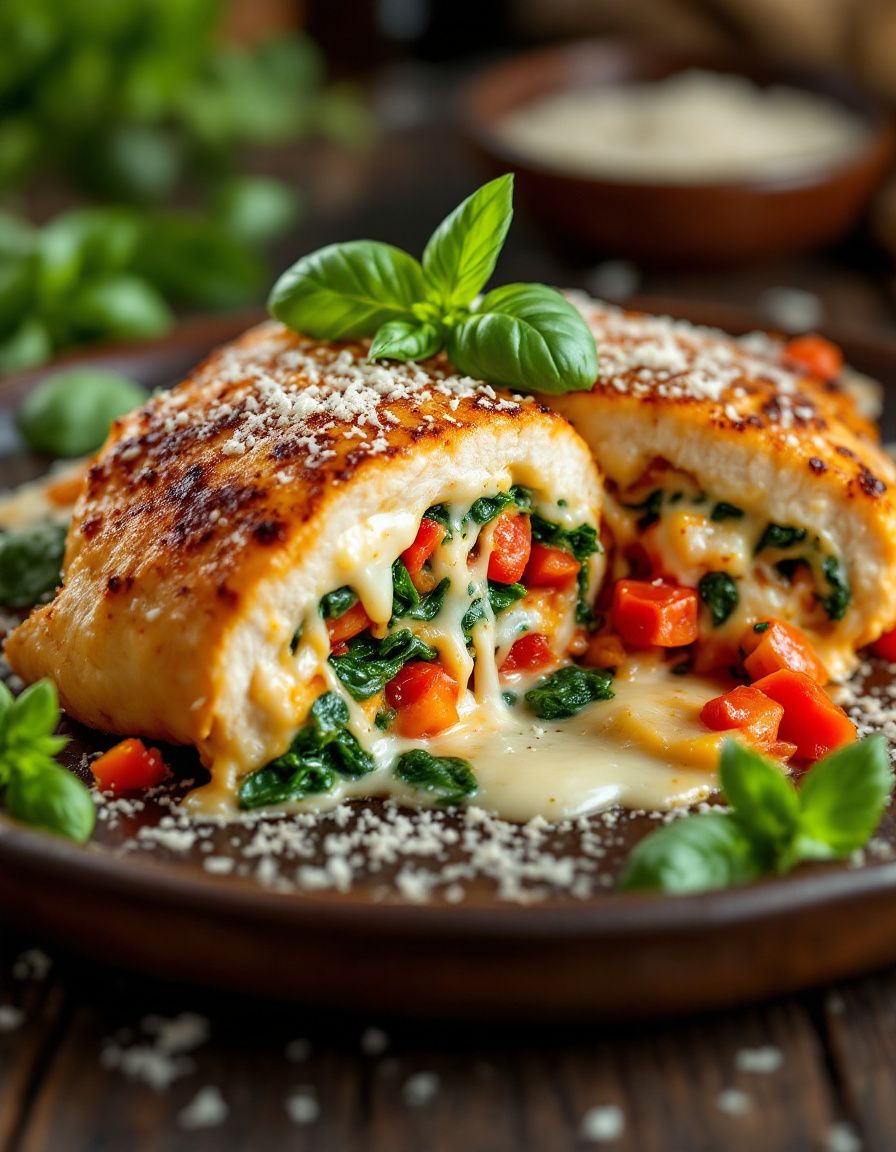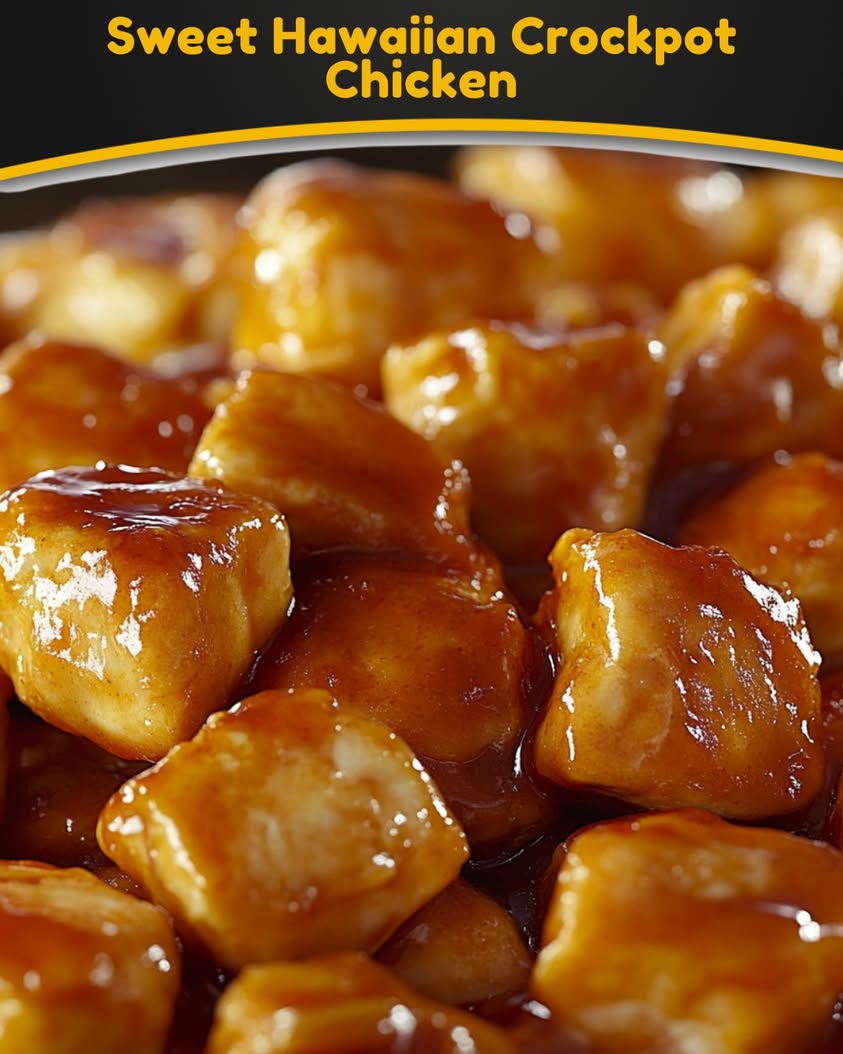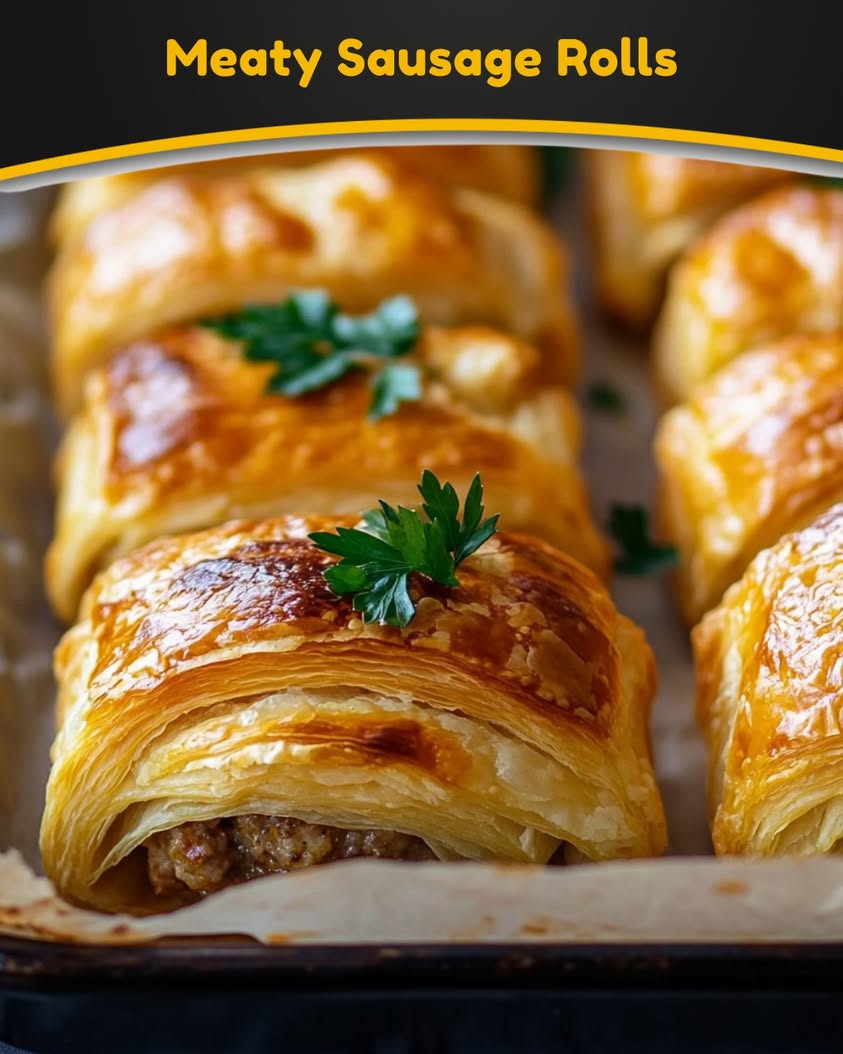Crockpot Beef Tips & Noodles: A Comforting Slow Cooked Delight
Crockpot Beef Tips & Noodles is the epitome of comfort food, perfect for cozy family dinners or a satisfying weekday meal. This recipe features tender beef tips simmered in a rich, savory gravy, enveloped in hearty, buttery egg noodles that soak up all the flavors. The combination of spices and fresh ingredients creates a dish that is both filling and bursting with home-cooked goodness.
Imagine coming home after a long day to the tantalizing aroma of beef slowly cooking away in your Crockpot. The smell alone is enough to make your mouth water and your heart feel right at home. This easy-to-make recipe delivers on taste, ease, and deep satisfaction, offering a take on a classic dish that’s been passed down through generations.
Quick Recipe Highlights
- Flavor Profile: Savory beef combined with a hint of garlic and onion creates a perfect symphony of flavors that brings comfort to your dinner table.
- Texture: The tender beef melts in your mouth, while the noodles provide a satisfying chewing contrast.
- Aroma: The rich, meaty aroma with notes of fresh herbs fills your kitchen, enhancing the anticipation of the meal.
- Visual Appeal: The dish is a beautiful medley of golden noodles and richly colored beef, topped with freshly chopped parsley for a pop of color.
- Skill Level Needed: This recipe is easy enough for beginners but rewarding for experienced cooks, making it accessible for everyone.
- Special Equipment: All you need is a Crockpot or slow cooker to whip up this delightful dish with minimal effort.
Recipe Overview
- Difficulty Level: The ease of preparation and straightforward cooking steps make this recipe perfect for anyone looking to create a comforting meal without a lot of fuss.
- Category: This recipe is ideal as a main dish, especially for family gatherings or potlucks.
- Cuisine: Influenced by American comfort food traditions, this recipe brings hearty flavors and warmth from the classic homestyle cooking era.
- Cost: This budget-friendly recipe utilizes inexpensive cuts of beef and pantry staples, making it a cost-effective meal choice.
- Season: Perfect for colder months, Crockpot Beef Tips & Noodles can warm you up when the temperature drops.
- Occasion: Great for family dinners, special occasions, or just a cozy night in, this dish suits various events.
Why You’ll Love This Recipe
The flavor of Crockpot Beef Tips & Noodles is the first thing that will capture your heart. The tender beef stews in its own juices, melding beautifully with the rich gravy and tender noodles. It’s not just a meal; it’s an experience. Each bite bursts with umami, satisfying your cravings while delivering comfort.
Convenience is another reason to love this recipe. With minimal prep work, you can set it in the morning, and by dinner, you will have a delicious meal ready to serve. This hands-off approach makes it perfect for busy families or anyone who enjoys meal prepping for the week. Just toss the ingredients into the Crockpot and let it work its magic.
This meal offers nutritional advantages too. Packed with protein from the beef and complex carbohydrates from the noodles, it provides energy and fulfills hunger pangs. You can even boost its nutritional value by adding vegetables like carrots or peas, making it a wholesome one-pot meal.
Crockpot Beef Tips & Noodles is also a fantastic dish for entertaining guests. The inviting aroma, coupled with a beautiful presentation, makes it a show-stopper at any dinner party. Plus, who doesn’t love a hearty meal that serves many? Your guests will rave about this dish. It not only fills empty stomachs but also fills hearts with joy.
Lastly, the cost-effectiveness of this recipe is unbeatable. Using economical beef cuts and staple ingredients, you can feed your family without breaking the bank. The ability to make a meal that feels indulgent without the price tag is something every home cook can appreciate.
Historical Background and Cultural Significance
The history of beef tips as a culinary offering is deeply rooted in traditional American cookery. Originating from rustic kitchens, the use of less expensive cuts of beef allowed families to create hearty meals without financial strain. This practice set the stage for what would later become the beloved slow-cooked beef tips.
In many cultures, slow cooking reflects a way of life that embraces patience and care in the kitchen. As families gathered around a warm meal at the end of a long day, recipes like beef tips evolved, becoming staples in American homes. This dish embodies the spirit of togetherness, comforting those who share it.
Over the years, the recipe has undergone various transformations, showcasing its versatility. Changes have been made to accommodate ingredient availability, regional flavors, and dietary preferences, keeping the essence of the recipe alive while adapting to modern tastes.
Today, Crockpot Beef Tips & Noodles represents a fusion of tradition and convenience, ideal for the fast-paced lifestyle while maintaining the classic comforts of a hearty home-cooked meal.
Ingredient Deep Dive
Beef Tips: Commonly derived from tough cuts of meat, beef tips benefit from slow cooking, which tenderizes the protein and infuses it with flavor. They are rich in iron, protein, and essential amino acids, making them a nutritious choice for hearty meals. When selecting beef tips, look for marbled cuts for added flavor and tenderness. Store in the freezer if not used immediately, and consider using beef stew meat or chuck roast as substitutions.
Noodles: Egg noodles are traditional in this dish for their ability to absorb the savory flavors of the beef gravy. They are a source of carbohydrates, providing energy. Opt for fresh or dried varieties based on preference; for extra nutrition, whole grain noodles are a great choice. Noodles can be stored in a cool, dry place, and dried options last longer than fresh. If you need a gluten-free version, consider alternatives like rice noodles or zucchini noodles.
Common Mistakes to Avoid
- Not browning the beef: Skipping the browning step can lead to less flavor in the final dish. Browning caramelizes the meat and adds depth to the overall taste.
- Overcrowding the Crockpot: Filling the pot too full can prevent proper cooking and lead to unevenly cooked ingredients.
- Using the wrong cut of beef: Tough cuts work best for slow cooking. Avoid lean cuts, which can dry out over time.
- Overcooking the noodles: Add the noodles during the last 30 minutes of cooking to prevent mushiness, as they can easily become overcooked in the slow cooker.
- Ignoring seasoning: Taste your dish and adjust seasoning before serving for enhanced flavor.
- Skipping fresh herbs: Adding fresh herbs towards the end brightens the dish and enhances its complexity.
- Not allowing for natural release: Quick venting of steam can lead to an abrupt change in texture. Allowing the pot to naturally release can add to the overall tenderness.
- Neglecting to check for doneness: Always check your meat with a fork or thermometer to ensure it’s fully cooked and tender before serving.
Essential Techniques
Browning the meat: This technique is crucial for flavor development. Start by heating your pan until hot, adding a bit of oil, and then placing the meat in without overcrowding. This will help achieve a golden crust, enhancing the overall flavor.
Using the slow cooker: Master this technique by layering your ingredients correctly—place tougher vegetables, such as carrots, on the bottom, followed by the meat and softer ingredients on top. This not only helps with even cooking but ensures that everything contributes to the flavor of your sauce.
Pro Tips for Perfect Crockpot Beef Tips & Noodles
1. For added depth of flavor, consider adding a splash of red wine or balsamic vinegar to the sauce before cooking.
2. You can enhance the richness by including a tablespoon of Worcestershire sauce or soy sauce in the broth for added umami.
3. Experiment with spices like thyme, rosemary, or bay leaves to elevate the flavor profile further.
4. If time allows, allow the dish to sit for 10 minutes before serving; this will allow the flavors to meld beautifully.
5. Always taste and adjust the seasoning right before serving to ensure bold and balanced flavors.
6. Consider adding a splash of cream at the end for an indulgent touch that enhances the sauce’s richness.
7. Serve with a side salad or crusty bread to soak up the delicious gravy.
8. For a twist, try incorporating different types of mushrooms or bell peppers for additional texture and flavor.
Variations and Adaptations
For regional variations, you can replace the traditional beef with brisket or even pork tips to create different flavor profiles. Seasonal adaptations can see the addition of root vegetables in the colder months or fresh herbs and lighter vegetables during spring and summer. For dietary modifications, consider using spiralized zucchini in place of noodles for a low-carb alternative. Flavor variations can be achieved by using different spice blends, while texture modifications might include adding a crispy topping made of bread crumbs and cheese before serving. Presentationally, serve in a deep bowl garnished with fresh parsley for a vibrant touch.
Serving and Presentation Guide
Plating is an art; serve your crockpot beef tips in a deep bowl for a homey appeal. A sprinkle of fresh parsley or chives can enhance visual appeal and add a touch of freshness. Traditional accompaniments include crusty bread or buttery rolls for sopping up gravy. For modern serving, consider pairing with garlic bread or a light salad to balance the richness. Always serve hot, ensuring the noodles remain slightly firm and the beef tender. For portion control, consider serving family-style so guests can take what they desire.
Wine and Beverage Pairing
When it comes to wine pairings, a full-bodied red like Cabernet Sauvignon complements the richness of the beef. For a lighter option, consider a medium-bodied Merlot to balance the meal’s flavors. Non-alcoholic alternatives could include sparkling water with a splash of lemon for a refreshing contrast. If you’re a coffee enthusiast, a robust dark roast can enhance the savory notes of the dish wonderfully. Serve all beverages chilled or at room temperature to elevate the dining experience.
Storage and Shelf Life
Store your leftover beef tips and noodles in an airtight container in the fridge for up to three days. For longer storage, portion the dish into freezer-safe bags, ensuring to remove as much air as possible. This can extend the shelf life to three months. Signs of spoilage include off odors or visible mold. Reheat gently on the stove or in the microwave, adding a splash of broth if necessary, and be sure to stir to ensure even heating.
Make Ahead Strategies
Prep your ingredients the night before by chopping the vegetables and measuring out the spices. Store everything separately in the fridge. You can also sear the beef ahead of time and refrigerate it until you’re ready to cook. This will save time in the morning and enhance your busy day. Assemble and place in the crockpot in the morning, and enjoy the aroma wafting through your home by dinner time.
Scaling Instructions
If you’re looking to halve the recipe, remember to adjust cooking times slightly to avoid overcooking. Doubling or tripling the recipe is possible, but ensure you have a large enough Crockpot. Equipment adjustments might include an additional pot or larger slow cooker, and you may need to extend cooking times slightly. Consider proper storage methods if you have leftovers from scaling up the recipe.
Nutritional Deep Dive
Crockpot Beef Tips & Noodles provide a hearty meal filled with protein, which is essential for muscle repair and growth. Macro breakdown typically yields a good balance of proteins and carbohydrates, vital for sustained energy. Rich in micronutrients like zinc and iron from the beef, this dish also offers dietary fiber if whole grain noodles or vegetables are included. Always be aware of portion sizes if you’re considering weight management; pairing this dish with lighter sides can help maintain a balanced diet.
Dietary Adaptations
For those seeking gluten-free options, substitute with rice noodles or spiralized squash. A dairy-free version can easily be achieved by using coconut milk instead of any dairy or cream-based elements. For a vegan take, substitute beef with hearty mushrooms or jackfruit, and replace the noodles with chickpea or lentil pasta. Other specific diets such as low-carb can focus on adding more vegetables while omitting noodles altogether.
Troubleshooting Guide
Texture issues can often arise from overcooking the beef or noodles; using a meat thermometer to ensure the beef reaches the right tenderness can help. Flavor balance may be adjusted by adding salt, sugar, or acidity like lemon juice. If your dish turns out colder than expected after serving, gently heat on the stovetop while stirring. For equipment challenges, ensure your slow cooker is suitable for the recipe and can handle the amount of ingredients. Ingredient substitutions should be thoughtful to maintain the recipe’s integrity, and timing adjustments may be needed depending on equipment efficiency.
Recipe Success Stories
Readers have shared glowing feedback about their experiences with this delicious dish. Many have reported successfully adapting the ingredient list to fit family preferences, leading to unique variations that still capture the essence of the original recipe. A few have shared that it’s become a staple for family gatherings and potlucks, receiving requests for the recipe from friends. Photography tips have also emerged from our community, emphasizing the importance of natural light and vibrant garnishes to make the dish look as good as it tastes.
Frequently Asked Questions
1. Can I use a different type of meat? Yes! While beef is traditional, chicken or pork can also be used for varying flavors. Just adjust cooking times accordingly as these meats can cook faster.
2. Is it necessary to brown the beef before putting it in the Crockpot? While it’s not strictly necessary, browning the beef enhances the flavor significantly and helps develop a richer sauce.
3. How do I discard leftovers? Store leftovers in an airtight container and refrigerate for up to three days or freeze for later use.
4. Can I make this recipe in advance? Yes! Prep ingredients ahead of time and assemble in the morning for a convenient meal. You can also freeze the dish for later enjoyment.
5. How can I make it spicier? For added heat, incorporate crushed red pepper flakes or a dash of hot sauce to the gravy before cooking.
6. What’s the best way to thicken the sauce? If you find your sauce too thin, create a slurry of cornstarch and cold water, then stir it into the gravy during the last 30 minutes of cooking.
7. Can I use frozen beef? It’s not recommended to put frozen beef directly into the Crockpot as it may not cook evenly. Thaw it out beforehand for the best results.
8. What sides pair well with this dish? This dish goes well with garlic bread, steamed green vegetables, or a light salad for a balanced meal.
9. How long can I cook it? Cooking for six hours on low is ideal for tender beef, but you can cook it longer if needed, especially on a low setting.
10. Can I add more vegetables? Absolutely! Add vegetables like carrots, celery, or peas to the recipe – they add great nutrients and flavor.
Additional Resources
If you enjoyed this recipe, explore similar comforting dishes like beef stew or creamy chicken and rice. Consider diving deeper into slow-cooking techniques to unlock more flavors and convenience in your kitchen. Understanding ingredient variations, especially with seasonal produce, can enrich your cooking experience. For further guidance, check out recommended equipment like quality slow cookers that can handle various recipes effectively.
Join the Conversation
We encourage you to share your experiences and modifications on social media using the hashtag #CrockpotBeefTipsNoodles. Post your recipe photos for a chance to inspire other cooking enthusiasts! We love hearing your feedback, and your reviews help our community to grow. Engage with fellow cooks and swap unique variations to make this dish your own.
The Recipe
Crockpot Beef Tips & Noodles
Serves: 4-6 servings
Prep Time: 15 mins
Cook Time: 6 hours
Total Time: 6 hours 15 mins
Kitchen Equipment Needed
- Crockpot or slow cooker
- Skillet (optional for browning)
- Measuring cups and spoons
- Cutting board and knife
Ingredients
- 2 lbs beef tips
- 1 onion, chopped
- 3 cloves garlic, minced
- 4 cups beef broth
- 1 tablespoon Worcestershire sauce
- 1 teaspoon salt
- 1/2 teaspoon black pepper
- 1 teaspoon dried thyme
- 1/4 cup all-purpose flour (for thickening)
- 2 cups egg noodles
- Fresh parsley, for garnish
Directions
- In a skillet, brown the beef tips over medium-high heat and transfer into the crockpot.
- Add onion, garlic, beef broth, Worcestershire sauce, salt, pepper, and thyme into the crockpot.
- Cover and cook on low for 6 hours, until beef is tender.
- In the last 30 minutes of cooking, add the egg noodles to the pot.
- Mix flour with a little water to create a slurry, then stir into the pot if you want a thicker gravy.
- Once done, garnish with freshly chopped parsley and serve warm.
Recipe Notes
- You can substitute beef with pork or chicken for variety.
- Feel free to add additional vegetables such as carrots or peas in the last hour of cooking.
- For a richer flavor, incorporate a splash of red wine into the beef broth.
